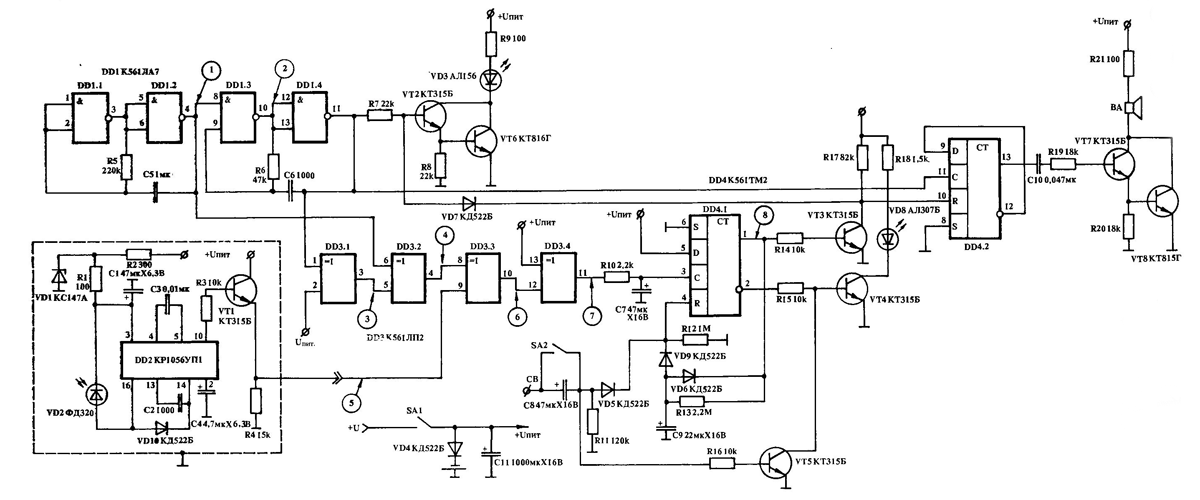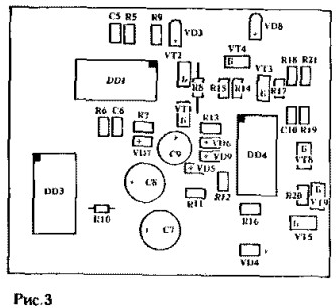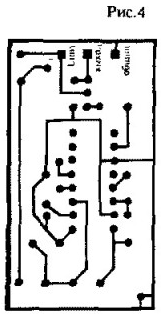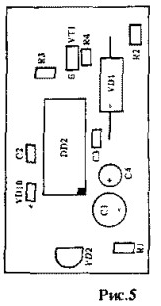Autonomous security device on infrared rays. Encyclopedia of radio electronics and electrical engineering

Encyclopedia of radio electronics and electrical engineering / Security devices and object signaling
 Comments on the article
Comments on the article
This device can be used to protect an object or as a signal sensor in automation devices for various purposes. Its feature is a compact design and full autonomy of operation due to the combination of an IR emitter and a reflected signal receiver in one housing.
After switching on, the device switches to standby mode after 6 seconds. When triggered by the presence of a foreign object, it emits an audible signal for 1,5 minutes, and then automatically switches to standby mode, which is indicated by the LED turning on. The sound signal can be interrupted manually with the "Reset" button, after 6 seconds. The device will return to standby mode.
Schematic diagram of the device is shown in Fig.1.

(click to enlarge)
Technical specifications
- Type of radiation ....... infrared rays with frequency modulation 10 kHz
- Operating mode ...... pulse with a frequency of 2 Hz
- Distance to the object to be determined......0,5 m
- Alarm duration......1,5 minutes
- Current consumption......100 mA
- Supply voltage ...... 7,5-12 V
- Overall dimensions......140x37x95 mm
On the elements DD1.1 and DDI.2, a generator of rectangular pulses with a frequency of 2 Hz is assembled. On the elements DD1.3 and DD1.4, a controlled pulse generator with a frequency of 10 kHz is made, which begins to generate oscillations only when a positive logical "1" signal is applied to pin 8 DDI.3.
The signal from the generators goes to the composite transistor VT6 and VT7, in the collector circuit of which the infrared LED VD3 is included. Thus, the LED operates in a pulse mode with a switching frequency of 2 Hz. The pulse mode of operation is selected in order to save battery power.
The photodetector is assembled on a DD2 chip. Reception of infrared vibrations is carried out on the photodiode VD2.
Since the DD2 chip is powered by a voltage of + 5V, a parametric converter for + 1V from + 2V is assembled on the elements VD5 and R9. To prevent the penetration of interference through the power circuits, a power filter for the DD2 microcircuit is used on the elements R1 and C1. Capacitors C2 and C3, C4 are elements that set the operating mode of the DD2 chip.
Next, the signal is fed to the comparator, which is made on the element DD3.3. If the signals at its inputs are equal in frequency and phase, a logical "3.3" is formed at the output of DD10 (pin 0), with a difference in frequencies at the output of DD3.3, a chaotic change in the levels "0" and "1" is observed. Therefore, when "spurious" signals hit the photodetector, the comparator generates an error signal. This ensures reliable, error-free operation of the device.
On elements C8 and R11, a circuit is assembled for delaying the transition of the device to standby mode after pressing the "Reset" button or after turning on the device. This is necessary so that a person can leave the security zone after turning on the device.
The transmitter and photodetector boards are shown in fig. 2,3 and 4,5 respectively.




The device uses K176 series microcircuits. They can be replaced by the same type from the K561, K564 series without changing the board design.
Capacitors K50-35 can be replaced with K50-I6, the rest of the K10-7V series can be replaced with KD. KT315B transistors can be replaced with KT315 with any letter, KTZ102A, B, KT816B - with KT602B, KT814B. Photodiode FD320 - on FD263. LED AL156 - on two series-connected AL107B, AL307 - on AL102B. Resistors - type MLT-0,125, MLT-0,25, Zener diode KT147A is replaced by KS156A. Diode KD522B - on KD521 with any letter.
Dynamic head - DEMSH.
Author: K.Afanasiev
 See other articles Section Security devices and object signaling.
See other articles Section Security devices and object signaling.
 Read and write useful comments on this article.
Read and write useful comments on this article.
<< Back
 Latest news of science and technology, new electronics:
Latest news of science and technology, new electronics:
Machine for thinning flowers in gardens
02.05.2024
In modern agriculture, technological progress is developing aimed at increasing the efficiency of plant care processes. The innovative Florix flower thinning machine was presented in Italy, designed to optimize the harvesting stage. This tool is equipped with mobile arms, allowing it to be easily adapted to the needs of the garden. The operator can adjust the speed of the thin wires by controlling them from the tractor cab using a joystick. This approach significantly increases the efficiency of the flower thinning process, providing the possibility of individual adjustment to the specific conditions of the garden, as well as the variety and type of fruit grown in it. After testing the Florix machine for two years on various types of fruit, the results were very encouraging. Farmers such as Filiberto Montanari, who has used a Florix machine for several years, have reported a significant reduction in the time and labor required to thin flowers.
... >>
Advanced Infrared Microscope
02.05.2024
Microscopes play an important role in scientific research, allowing scientists to delve into structures and processes invisible to the eye. However, various microscopy methods have their limitations, and among them was the limitation of resolution when using the infrared range. But the latest achievements of Japanese researchers from the University of Tokyo open up new prospects for studying the microworld. Scientists from the University of Tokyo have unveiled a new microscope that will revolutionize the capabilities of infrared microscopy. This advanced instrument allows you to see the internal structures of living bacteria with amazing clarity on the nanometer scale. Typically, mid-infrared microscopes are limited by low resolution, but the latest development from Japanese researchers overcomes these limitations. According to scientists, the developed microscope allows creating images with a resolution of up to 120 nanometers, which is 30 times higher than the resolution of traditional microscopes. ... >>
Air trap for insects
01.05.2024
Agriculture is one of the key sectors of the economy, and pest control is an integral part of this process. A team of scientists from the Indian Council of Agricultural Research-Central Potato Research Institute (ICAR-CPRI), Shimla, has come up with an innovative solution to this problem - a wind-powered insect air trap. This device addresses the shortcomings of traditional pest control methods by providing real-time insect population data. The trap is powered entirely by wind energy, making it an environmentally friendly solution that requires no power. Its unique design allows monitoring of both harmful and beneficial insects, providing a complete overview of the population in any agricultural area. “By assessing target pests at the right time, we can take necessary measures to control both pests and diseases,” says Kapil ... >>
 Random news from the Archive Random news from the Archive Developed the finest ion sieve
09.09.2021
Researchers at the King Abdullah University of Science and Technology (KAUST) have shown that the parameters of ion-screen polymer membranes can be controlled with high precision.
It is known that the mechanism of transmission of nerve impulses in animals and the contraction or relaxation of muscles involve the transfer of sodium and potassium ions across membranes. If fabricated membranes could achieve this kind of ion selectivity, it would be possible to transform many technologies, such as water treatment and mining.
Ions are formed when atoms or molecules lose or gain electrons, thereby gaining a positive or negative electrical charge. Sodium, lithium or chloride ions are less than 1 nanometer (10-9 meters) in diameter.
The researchers used the known sizes of the ions to determine the monomers from which the membrane could be constructed. A monomer is a molecule that forms compounds with other particles and is part of the polymer as its structural unit. For example, ethylene, like other hydrocarbon molecules, is a monomer. The membranes themselves were made by the method of electropolymerization - the deposition of films from monomer solutions on the surface of electrically conductive materials.
Before it was possible to get a successful result, scientists went through more than a hundred samples. However, the resulting membranes outperformed all those previously made in tests using solutions containing ions.
The most obvious application is the removal of salt ions from sea water to produce drinking water. Membranes that selectively pass the ions of interest to us can be used both in a new generation of more accurate and flexible sensor technologies, and in batteries that also work by ion transport.
|
 Other interesting news:
Other interesting news:
▪ Worm is enough for one tape
▪ Smart diaper on Intel platform
▪ MAX14851 - universal 6-channel 600V digital isolator
▪ Transcranial magnetic stimulation improved short-term verbal memory
▪ Milk began to drink in the Urals
 News feed of science and technology, new electronics
News feed of science and technology, new electronics
 Interesting materials of the Free Technical Library:
Interesting materials of the Free Technical Library:
▪ section of the site Visual illusions. Article selection
▪ article Who are you with, masters of culture? Popular expression
▪ article Where do rheobatrachus frogs develop and where do they come from? Detailed answer
▪ article Performing work in the display class. Standard instruction on labor protection
▪ article A quartz resonator converts non-electric quantities into electrical ones. Encyclopedia of radio electronics and electrical engineering
▪ article Electric motors and their switching devices. Installation of electric motors. Encyclopedia of radio electronics and electrical engineering
 Leave your comment on this article:
Leave your comment on this article:
 All languages of this page
All languages of this page
Home page | Library | Articles | Website map | Site Reviews

www.diagram.com.ua
2000-2024







 Arabic
Arabic Bengali
Bengali Chinese
Chinese English
English French
French German
German Hebrew
Hebrew Hindi
Hindi Italian
Italian Japanese
Japanese Korean
Korean Malay
Malay Polish
Polish Portuguese
Portuguese Spanish
Spanish Turkish
Turkish Ukrainian
Ukrainian Vietnamese
Vietnamese





 Leave your comment on this article:
Leave your comment on this article: